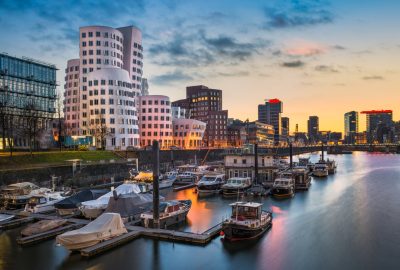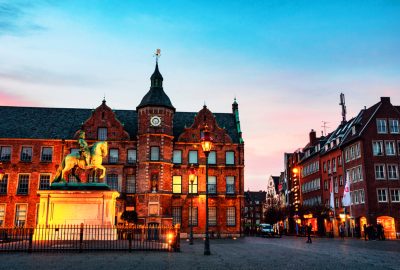Düsseldorf is to my opinion the most artsy and colourful city in Germany. It doesn’t get as much hype as the nearby and rival city Cologne but I believe it is a far more interesting and fun travel destination. No wonder the Federal state of North Rhine-Westphalia took it as its capital city. Düsseldorf’s location is impeccable; it’s a short ride away from the Netherlands and Belgium. You can even see Cologne from atop of the Rhine Tower. It’s an impressive viewing platform overlooking the city and the Rhine River. You can even take a cruise to along its banks and the lively riverside promenade. Nearby is also the Medienhafen (Media Port), an old inner harbour that was transformed into a working area for the city’s creatives and hangout of the local hipsters. Here you can find some architectonic masterpieces of for instance Richard Meier, Helmut Jahn and Claude Vasconi. The most famous building in this area is the Neuer Zollhof, a trio of colourful avant-garde residences designed by Frank Owen Gehry. This Canadian-born American architect from LA signed up for some the most famous works of contemporary architecture in the world such as the Guggenheim Museum in Bilbao, the Walt Disney Concert Hall in Los Angeles and the office of the Louis Vuitton Foundation in Paris.

Medienhafen (Media Port) in Dusseldorf: an old harbour that became home to many different media companies, and transformed into a hip area with nice restaurants and bars
An interesting part of Düsseldorf is its large Japanese community. Ruhr region has always been a business magnet and Asians wouldn’t miss out on that. Düsseldorf is currently the largest “nipponjin” community outside of Japan. Is business the only thing that these two countries have in common? I don’t think so. This deep friendship began during the Meiji Era when the Japanese opened up to western culture after almost 200 years of seclusion. Germany, among other western superpowers, served as a model for Japans race to modern civilization. As the story goes, Japan considered themselves better than the other Asian countries. Germans thought themselves better than all the other races. So, they sort of shared this weird point of view, they also had a similar work ethic. That was enough to ally with the Nazis and fight alongside them. They both got their asses kicked but the friendship remains. They celebrate this unusual bond during the annual Japan Day in Düsseldorf. It takes place towards the end of May on the Rhine promenade and includes a variety of events. The city turns into Tokyo for that one day, concluded with a stunning firework show. There’s cosplay (Japanese costume play), anime, calligraphy, kimonos and all the delicious weirdness that we learned to love about Japan.
The Carnival is another large-scale party in Düsseldorf. It might not hold a candle to the one in Rio but it gets wild nonetheless. The revelry starts on Thursday with the symbolic ritual of cutting the mayors tie. People storm the best bars and pubs around the Old Town and party until early morning hours. They take a break on Saturday, most people spend the day with their families. Sunday celebrations continue around the Königsallee, Düsseldorf’s upscale shopping and fine dining street. The Carnival is concluded with a huge Rose Monday Parade. People dress up and dance on the streets. They sure know how to party, furthermore, they have mastered the art of drunken sustenance. You can find goodies like Canadian poutine at Frittenwerk at Friedrichstraße 145, all kinds of Currywurst and the traditional Soleier. You take a boiled egg, remove the yolk, mix it with vinegar, mustard, seasoning and stuff it back into the egg white. It’s a common snack that goes well with local Altbier ale. Have a shot of Killepitsch, Düsseldorf’s herbal liquor and you’re set to conquer the night. Some of the best bars are located around the Old Town, some even go as far as calling it “the longest bar in the world”. While in the beginning of the year the focus is on the carnival, in December the Christmas markets start opening up all over Düsseldorf. Stuff yourself with sausages and other grilled goodies and keep yourself warm with Glühwein. The season is no laughing matter in this part of Germany. And in between all these events you can always shop till you drop. Düsseldorf is a shopping paradise and its Königsallee is one Germany’s most exclusive and expensive shopping avenues. The world most famous perfumery, cosmetics, watches, jewelry, and fashion brands for all those who can afford to run their credit card red.

Altstadt: the cosy fairly small historical center of Dusseldorf with chic cocktail bars, dance clubs and pubs offering traditional Altbier
Düsseldorf is not just fun and games. It’s like Vienna's spiritual successor with tunneled ears. Or like San Francisco back in the good old days. “Oh my gosh Mum, I don’t want your classical music, I want Kraftwerk!”, “Mum, I don’t like this architecture with pillars and arcs, I want colourful spider people on facades of my buildings!”, “Your ballroom dancing is boring, Mum, I’d rather do raves!”. Let’s be honest: electronic music nowadays would not have been the same without Kraftwerk, formed in Düsseldorf in 1970 by Ralf Hütter and Florian Schneider. They were true innovators and pioneer. Their German kraut-rock rooted arrangements and electronic tunes coming from the synthesizer, drum machine and of course the vocoder (voice transformer) paved the path for synth pop, post-punk, techno, ambient, and even contemporary club music. I was lucky to see them perform on a festival during their latest and maybe even last tour in Europe. Their live show with 3D and other visual effects was a mind-blowing experience, a hallucinating trip without the drugs.
Counterculture is an integral part of this city. It’s ever so apparent around the Kiefernstraße, an industrial area meant to accommodate the employees of Klöckner steelworks. Those eventually closed down and the area went into somewhat of a disorder. Unemployed workers needed a place to stay so Kiefernstraße quickly became the squatter central of Düsseldorf. It used to be quite the dangerous place to live in with gangs likes Baader–Meinhof Group owning the streets. Nowadays it’s a multi-cultural haven for punks, anarchists, artists, and vagabonds from all over the world. There is a ton of graffiti, old construction carts, live music and fascinating people to befriend.



No one commented yet. Be the first.